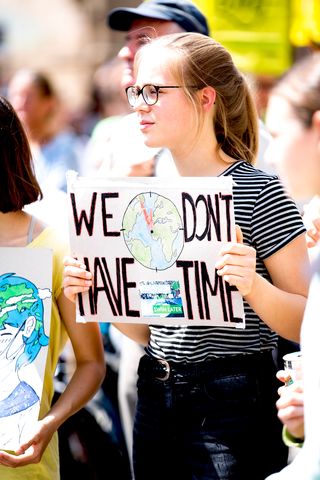Pornography
Disaster Porn, In Two Forms: Watching the End of the World
Fear-based messaging can promote behavioral changes, but it can also backfire.
Posted September 27, 2019

In the article and 2019 bestseller on catastrophic climate change The Uninhabitable Earth, David Wallace-Wells tells an ecological horror story in harrowing, nightmarish detail. The short version? If we do nothing to significantly reduce greenhouse gas emissions, apocalypse is now. Or, paraphrasing Wallace-Wells, “I know you think you know it’s bad, but it’s far worse than you think.” Taking exception to a “doomist framing” (sometimes called "disaster porn"), some climate scientists (e.g., Michael Mann and Kevin Trenberth) and academics (e.g., Daniel Cohen, a sociologist) assert that one does not wish to overstate the science, or depress or discourage public audiences with end of the world diatribes. This is to say, even if one is not exaggerating the dire nature of our circumstances, couldn't one do it with just a bit more cheer (think Apocalypse Now: The Musical)? As Emily Atkin (2017) observed, "complaints about the science in Wallace-Wells’s article are mostly quibbles. Climate scientist Kevin Trenberth took issue with a section titled “The End of Food,” noting that while climate change could have a significant impact on food systems, food itself won’t disappear. 'It is overly dramatic but has a basis in fact,' he said."
So, if there was any consensus in the critiques of Wallace-Wells’s scenarios, it is that he employed some degree of hyperbole in painting a picture of what could happen and didn’t hold audience members’ hands and buoy their spirits with a balance of sufficient solutions and a soothing salve of optimism. Why was he loathe to give readers a happy ending? Atkin confirms that while he nods to geoengineering and gestures to the highly controversial idea that we dump sulphur dioxide into the lower stratosphere to block sunlight, Wallace-Wells then “described many of the scientists he interviewed as ‘improbably’ optimistic, adding that ‘climate scientists have a strange kind of faith: We will find a way to forestall radical warming, they say, because we must.”’
Scientists do keep saying that they’ve got a line on a solution should things get really bad in the near future. But these “solutions,” like the sulfur dioxide seeding project, seem to involve treating the symptoms or sequalae, not addressing the driving causes of the crisis. Such solutions seem woefully reductionistic and linear at times (see my blog You Are Here: Welcome to the Anthropocene for a discussion of how bad thinking gets us in a world of trouble), and do not model the world as it is. Meanwhile, the policies of the administrations in a number of countries (e.g., China, U.S., and India as the top three carbon emitters), and Brazil with deforestation of the Amazon) make it clear that economic development is still king, and corporations and stockholders want to see their earnings go up every quarter, no matter the long term cost. If one does not have the ear of world leaders or captains of industry, one might see oneself painted into a corner, reduced to end runs and endgames far down the chain of major contributors to climate change. Muffled, ignored, and fired from their respective positions in government, scientists are left to “go back to the lab” to devise Hail Mary passes to avert our extinction.
But the peril of this form of disaster porn is that people get turned off and tune out doomy predictions. Stevenson and Peterson (2016) asserted that while fear-based messaging can promote behavioral changes, it can also backfire “when individuals perceive low levels of agency or control” (p. 2). Without hope, fear takes over, and persons “perceive climate change as out of their control or fail to see how they can make a meaningful difference, they may cope with feelings of fear by denying that there is anything to be concerned about or conclude that attempts to build concern are manipulation instead of education” (p. 2). Climate scientists want folks to pay attention, to feel a sense of urgency and responsibility, and to go out and do something, like eating less red meat and voting for persons who subscribe to climate science and do not engage in endless equivocation and hemming and hawing about what might be true. They don’t want the public to change channels or become so depressed that they do nothing and fulfill the fateful prophecy. If we want to see action, we need to avoid shutting people down by: 1) not going overboard when suggesting what could happen in worst case scenarios, but sticking closely to what we actually know, and 2) inviting folks to consider daily, doable personal actions that make a difference. For instance, I shopped for an electric vehicle this past weekend; the new ones have a decent range, good acceleration, and style appeal. And two recharging stations just appeared a block from my house. It's a real option.
Pass the Popcorn. And then there are folks just want to have fun, and for whom watching the world end is the highest form of entertainment. As a licensed family therapist, I wonder why people would invest hours watching films like Deep Impact (1998), The Core (2003), The Day After Tomorrow (2004), 2012 (2009), and the eminently forgettable, and lowest-rated Disaster Wars: Earthquake vs. Tsunami (2013). These films depict our world ending, and there’s really no place to go, but if the protagonists can just take off in a plane from that crumbling runway in time, they’ll live to see another hour or day.

The content is bleak and anxiety-provoking, and the terrible scripts and lousy science undergirding them are simultaneously laughable and depressing. I thought folks watched movies to take a break from reality and to go on a mental vacation. But doomsday isn’t a “distraction,” “light entertainment” or science fiction anymore. There is something perverse about our species investing millions of dollars producing these films to make even more millions, and people flocking to theaters to watch and pass the popcorn in their air-conditioned space while the world’s thermostat continues to rise outside. Cinematic disaster porn depicts the earth’s imminent end and does so gratuitously without teaching the audience a blessed thing that might lead to consciousness raising, a paradigmatic shift, or better outcomes out here in the real world. If aliens visited Earth after our extinction, a review of the films in this form of disaster porn would prompt a question: “They knew; they knew what was happening, and this, this, was their response?” So, my friendly amendment to Greta Thunberg’s famous tweet is: “I don't want your hopelessness. Or your denial, flight or freeze. Pay attention, think systemically, and vote accordingly. There are things you can do. Do three of them.”
References
Atkin, E. (2017). The power and peril of “climate disaster porn.” Retrieved August 24, 2019 at https://newrepublic.com/article/143788/power-peril-climate-disaster-porn
Stevenson, K. & Peterson, N. (2016). Motivating action through fostering climate change hope and concern and avoiding despair among adolescents. Sustainability, 8(6), 1-10. Retrieved September 3 2019 at http://www.mdpi.com/2071-1050/8/1/6/pdf
Wallace-Wells, D. (2017). The uninhabitable Earth. Retrieved August 24, 2019 at http://nymag.com/intelligencer/2017/07/climate-change-earth-too-hot-for….
Wallace-Wells, D. (2019). The uninhabitable Earth: Life after warming. New York: Tim Duggan Books.


